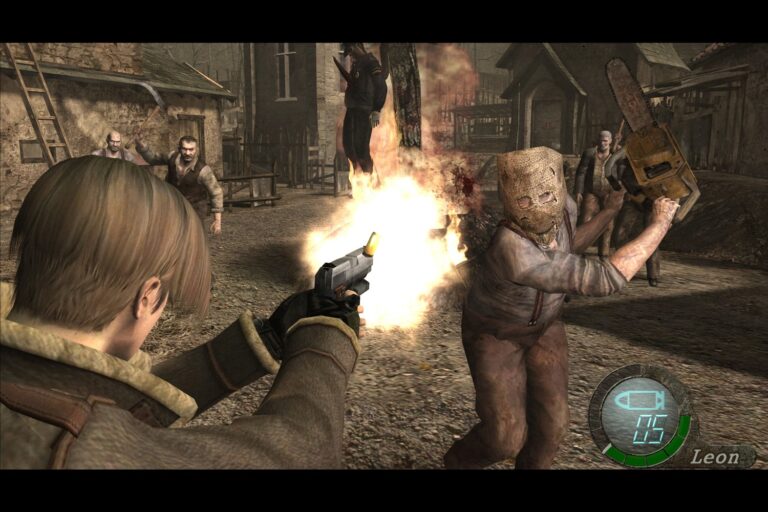Very few games can claim to be truly revolutionary, but Resident Evil 4 has both feet firmly in this category.
Launched in January 2005 originally as a Nintendo GameCube exclusive, Capcom’s flagship title wasn’t just a game-changer for survival horror — it also set the blueprint for many of today’s third-person shooters. It’s also been credited with saving a franchise that might have been dead on arrival in its absence.
Despite its critical and commercial success, Resident Evil 4 had its fair share of languishing in development hell. After Capcom horror auteur Shinji Mikami stepped back from directing after working on the stellar Resident Evil and its 2002 remake, RE2 director Hideki Kamiya took the reins, but his vision of creating a far more action-oriented arcade-style game represented too much of a departure from RE’s roots. Not that Capcom execs were keen to pull the plug on Kamiya’s work — this formula was spun off into its own successful series: Devil May Cry.
In 2002, Resident 3: Nemesis alumnus Hiroshi Shibata was placed at the helm. Early concepts of the game showcased RE2’s rookie cop Leon S. Kennedy back in action, this time in a castle fending off enemies while infected with a mystery virus.
However, after the lukewarm success of prequel Resident Evil Zero and various other spinoff games, Shinji Mikami knew the series needed a more focused, fresh reimagining and scrapped Shibata’s demos. Now, stepping into directorial duties again, Mikami wanted to shift away from RE’s traditional fixed camera angles, which were severely limiting for players wanting more immersive environments than the processor-limited backdrops of the PS1 era.
With production costs spiralling out of control, Mikami whipped up RE4’s story in just three weeks, shifting the story from Raccoon City and plonking it within rural Spain, tasking Leon to save the kidnapped US President’s daughter from the evil cult Los Iluminados. Shady corp Umbrella also took a backseat to proceedings, and even RE’s trademark zombies were given the boot. Instead, they were replaced by Ganados, once-ordinary villagers now infected by a mind-controlling parasite known as Las Plagas, with a penchant for knives, pitchforks and chainsaws.
Crowd control
RE4’s first 20 minutes rocked first-time gamers hard. Upon your discovery at the game’s opening village level, you’re immediately beset by a horde of angry villagers, understandably miffed with you stomping around their land. You can take refuge in a small house, but the barricades won’t hold for long — enemies stream in through the front door and even on the windowed floor above. Still, like holding off a tidal wave with a teaspoon, you aim your pistol and let fly with some rounds. As terrifying as this ordeal is, it offers a sandbox for you to test the game’s combat mechanics.
Shoot a kneecap, and your opponent hits the ground, allowing Leon to roundhouse kick them and any others back to regain some much-needed personal space. You can shoot TNT out of enemies’ hands to reverse Uno that dynamite, while you can even deflect lobbed axes straight out of the air with your bullets. And you’ll never tire of pushing ladders over with enemies still on them and watching as they hurtle to the floor.
In the thick of this frantic encounter, you suddenly hear the menacing gears of a chainsaw whir into life, before being set upon by the sack-hooded villain wielding it. This is Dr. Salvador, who can soak up a ton of damage and gruesomely lop your head off in a single hit.
With dozens of enemies on screen, finding your groove with the combat is paramount, and firing blind down a corridor original-RE style isn’t going to cut it anymore. That’s why RE4 fixes the camera angle behind Leon, only snapping to an over-the-shoulder precision mode when holding the aim button. This also activates a laser dot so you know what you’re aiming at before unleashing the claret.
Love at first sight
It’s a system that has been adapted in countless other action titles, such as Dead Space, The Last of Us, and Gears of War. And the tank controls perfectly balance the frantic need to find a few precious feet of shooting space while staying accurate with your firearm.
Gamers also unwittingly encounter a hidden mechanic to keep them on their toes: adaptive difficulty. Skilled combatants who nail headshots and avoid damage have to deal with increased and more aggressive enemies, while lacklustre agents on the verge of meeting their maker might also meet fewer enemies and increased ammo drops.
Speaking of enemy types, there’s a whole menagerie to dispatch, with multiple ganado types, invisible insects, xenomorph-style hybrids, armoured Wolverwines and massive ogres all wanting your pounds of flesh. Plus, there’s the terrifying Regeneradors who just want to bring it in for a nice, spiky hug.
Gameplay is as diverse as the enemy types too, with several on-rails sections, including a classic minecart ride, a terrifying cabin invasion encounter, and the infamous water hall that’ll fully tax your multitasking. There’s even a shooting gallery that serves as a nice change of tone in between parasite popping.
While some levels, such as the Castle and Island, can feel relentless, its diverse enemy encounters and varying puzzles keep things fresh, while upgrading your arsenal of weapons always feels well-earned and consequential.
Despite being more action-oriented than survival horror purists might like, Resident Evil 4 still holds up, even if some of the corny dialogue hasn’t aged terribly well. Even though the game began life as a GameCube exclusive, it was ported across multiple formats more than ten times, including an HD remaster, a Wii version with added “waggle,” a full VR campaign and mobile versions. In 2023, RE4 was fully remade to universal acclaim, further cementing its legacy as one of the greatest games ever made.
Read the full article here
